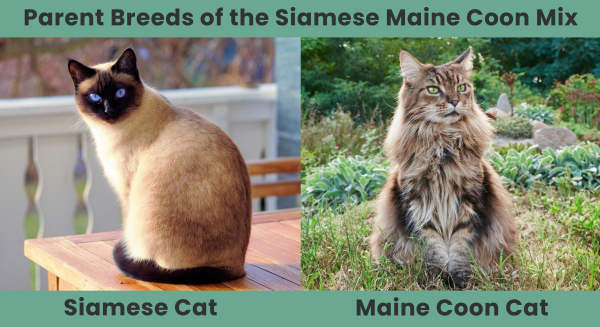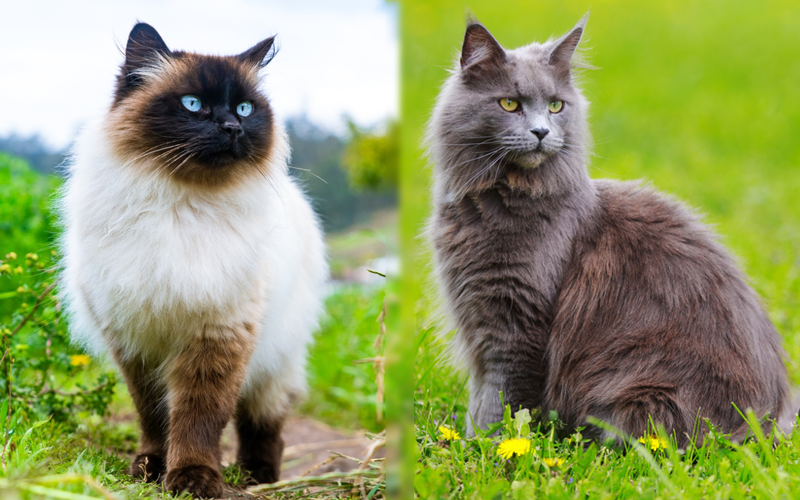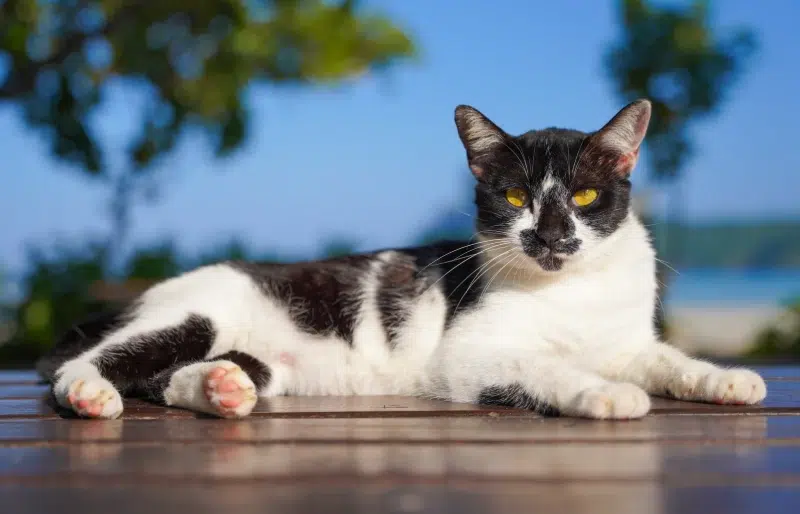Click to Skip Ahead
Breed Overview
Height:
8–16 inches
Weight:
15–22 pounds
Lifespan:
8–15 years
Colors:
Any combination, point patterning, ticked patterning
Suitable for:
Owners looking for a gentle cat, owners who work from home, and families who want a talkative cat
Temperament:
Loyal & loving, talkative, easy-going, people-centered, gentle
The Siamese Maine Coon is a mix unlike any other. Combining the size and gentle strength of the Maine Coon with the talkative mischief of the Siamese, this crossbreed brings joy to everyone lucky enough to own one.
The Siamese Maine Coon is ideal for families, and they are ultimately happiest when they’re around their humans.
Siamese Maine Coon Mix Characteristics
Siamese Maine Coon Mix Kittens
Siamese Maine Coon kittens are adorable, and their large paws seem too big for their bodies. This is because they’ll have a lot of growing to do, particularly if they take after their Maine Coon parent! Finding breeders shouldn’t be too difficult since both are very popular breeds. However, being prepared for your kitten is imperative.
Siamese Maine Coon kittens will be as rambunctious and bold as any other. However, their large size and need for attention should be considered before you dive in and adopt one. They’ll need someone around throughout the day more than other breeds, and you’ll need sturdy play equipment that can safely handle their size as they grow.

Temperament & Intelligence of the Siamese Maine Coon Mix
The Siamese Maine Coon is an intelligent crossbreed, and Siamese and Maine Coon cats are often described as almost “dog-like” in behavior. They need someone home with them for much of the day since they love being around people.
While the Maine Coon is more laid back than the Siamese, the Siamese Maine Coon will likely be talkative thanks to their Siamese parent. Because of their intelligence, they can be taught tricks and walked on a leash with a harness, which is an excellent exercise for them.
However, it also means they need lots of mental stimulation. Puzzle feeders and toys are an excellent way to keep your Siamese Maine Coon Mix engaged and entertained while you’re working out of the house, as they’ll likely be right on your lap or pining while you’re away.
Are These Cats Good for Families? 👪
The Siamese Maine Coon Mix is an excellent family pet if you have the space for them. The large cats are a good choice for families with children. They live for affection and attention and do well in a busy family environment where they can be the center of attention.
They’re not usually skittish if they’ve been properly socialized, and they can comfortably navigate a bustling family home and are confident around visitors.
Does This Breed Get Along With Other Pets?
The Siamese Maine Coon is an easy-going feline that can get along well with other cats and dogs if they’ve been well socialized. Both the Maine Coon and Siamese are known to be confident, and the Siamese Maine Coon should handle social interactions with other pets well.
They will enjoy the company of another pet to play with while their owners aren’t home, but it depends on the individual. It’s important to remember that while the Siamese Maine Coon Mix inherits the traits from their parents, socializing them with other cats and dogs from kittenhood is extremely important to ensure they’re comfortable and happy.
They can still experience stress and fear when introduced to pets they’ve never encountered, so it’s crucial not to assume they’ll be fine just because their parents were! Small furry pets such as rabbits or hamsters should never be left alone with your Siamese Maine Coon since they’re prolific hunters thanks to their Maine Coon heritage.
They have a high prey drive, so keep your small pets safely out of harm’s way in an area your Siamese Maine Coon cannot get to prevent tragedies from occurring.
Things to Know When Owning a Siamese Maine Coon Mix:
Before you adopt a Siamese Maine Coon, take a lot at some of their care requirements, including food, exercise, and health concerns.
Food & Diet Requirements 🐡
Your Siamese Maine Coon will need a balanced and nutritious diet. The nutritional requirements of your Siamese Maine Coon Mix will depend on how big they end up. Large breed cats like the Maine Coon need specific amounts of calories and protein to ensure they grow at the correct pace, so your Siamese Maine Coon Mix will likely need the same if their parents are big.
Animal proteins should be the first ingredient in your Siamese Maine Coon Mix’s food, no matter what your budget. Try to get the best food you can afford, and use feeding guidelines from the packaging or your vet to ensure your Siamese Maine Coon stays in shape. They can suffer from joint problems, so keeping them at a healthy weight is imperative.
Exercise 🐈
Siamese Maine Coons are full of energy as kittens (as most are), so they’ll need plenty of toys and stimulation to keep them occupied. As they grow, they slow down and aren’t as active. However, the Siamese Maine Coon isn’t a lap cat and needs plenty of playtime to keep them trim and their joints supple.
Because of their size and need for space, taking your Siamese Maine Coon out for walks on a leash and harness can be a great way to exercise them. Just be ready for people to stop and ask you questions about them!
Training 🧶
The Siamese Maine Coon is an intelligent crossbreed, thanks to their clever parents. They can learn tricks such as fetch and give paw, be harness trained, and even perform showier tricks!
Short training sessions are ideal for Siamese Maine Coons; they stimulate their minds and are a great bonding activity. Positive reinforcement is the only method you should use, which involves using treats and praise as rewards for good behavior.
Grooming ✂️
Your Siamese Maine Coon’s grooming needs depend heavily on the type of coat they inherit from their parents. Some Siamese Maine Coons inherit a shorter, glossier coat similar to their Siamese parents. They need brushing a few times a week to remove dead hair and promote skin health, and they’ll likely have slightly longer hair than the Siamese but not enough to require intense grooming.
On the other hand, Maine Coons have very long, thick hair that requires daily brushing to keep it in check and tangle-free. If your cat inherits the Maine Coon’s luscious fur, a wire comb with rounded tips can keep their dense undercoat knot-free.
Pay particular attention to your Siamese Maine Coon’s hind legs, rump, “armpits,” and behind their ears; they’re more likely than others to develop tangles.
Health and Conditions 🏥
Because the Siamese Maine Coon is a crossbreed, you may think they’re healthier than their purebred parents. While that can sometimes be the case, the Siamese Maine Coon is vulnerable to health conditions that they can inherit from their parents, which can have a serious impact on their lives.
Luckily, the likelihood of a Siamese Maine Coon inheriting genetic health conditions commonly found in Maine Coons and Siamese is lower than purebred cats because of the diversity in their genes.
- Obesity
- Dental disease
- Asthma
- Megaesophagus
- Dermatitis
- Hyperesthesia
- Glaucoma
- Strabismus
- Hypertrophic cardiomyopathy
- Hip dysplasia
- Progressive retinal atrophy
- Lymphoma
- Arthritis
- Mast cell tumors
- Amyloidosis
- Diabetes
Male vs Female
Male cats are usually larger than females, and the same is true of the Siamese Maine Coon Mix. It’s more apparent if they take after their Maine Coon parent since male Maine Coons can be several inches larger (and pounds heavier) than their female counterparts! Male cats tend to have broader faces than females, and females are more daintily built.
3 Little-Known Facts About the Siamese Maine Coon Mix
1. Maine Coons Were the Biggest Domestic Cats in The World
Up until the development and spread of the Savannah cat in the 1980s, the Maine Coon was known as the largest domestic cat breed in the world (and is still considered the largest non-hybrid).
The world record for the longest domestic cat is held by a Maine Coon named Barivel of Italy, who measures a staggering 47 inches long!
2. There’s No Way to Know What Your Siamese Maine Coon Mix Will Look Like
Because the Siamese Maine Coon is a crossbreed, an unpredictable mix of traits from both their Maine Coon and Siamese parents can be inherited and expressed.
Your cat may be big and fluffy like the Maine Coon but be clingy and vocal like the Siamese. They may have the slender, exotic head shape of the Siamese or the wide and bold muzzle of the Maine Coon.
3. The Siamese is One of the Oldest Breeds in the World
Texts depicting Siamese cats originating in Thailand date back to as early as the 14th century when Thailand was known as Siam. They were revered at the time, and their original name, “Wichien-maat,” in their native language, translates to “moon diamond.”
 Final Thoughts
Final Thoughts
The Siamese Maine Coon is a cat like no other. Their parents’ vastly different physical attributes can give them a unique appearance, but they’re always loving and loyal. They’re intelligent and affectionate, making them excellent family pets. They get along well with children and tolerate most pets. The Siamese Maine Coon is a cat that will undoubtedly turn heads should you be lucky enough to own one!
See also:
Featured Image Credit: Left: Siamese cat (ecuadorplanet, Shutterstock), Right: Maine Coon (Utekhina Anna, Shutterstock)











